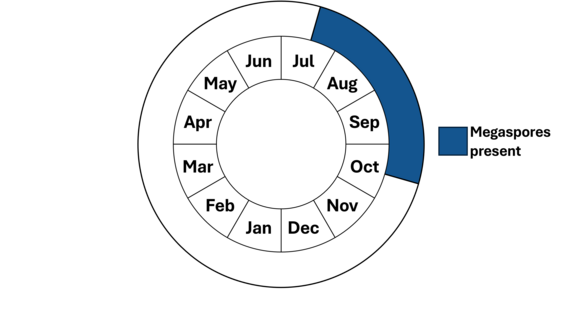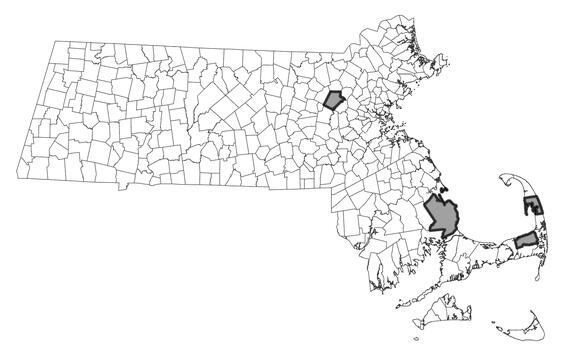- Scientific name: Isoete acadiensis
- Species of Greatest Conservation Need (MA State Wildlife Action Plan)
- Endangered (MA Endangered Species Act)
Description
Acadian quillwort (Isoetes acadiensis) is a globally rare, perennial aquatic non-flowering plant of the quillwort family (Isoetaceae). A relative of ferns, this inconspicuous species lives submerged in ponds and lakes as a rosette of linear leaves (somewhat resembling chives) and reproduces via spores.
The rosette of Acadian quillwort is composed of rigid, awl-shaped, dark olive-green to reddish-brown leaves. Reaching up to about 20 cm (8 in) in height, the leaves emerge from a very short, thick stem, anchored in the substrate by a subterranean corm. The leaf bases are broadly swollen and flattened in a concave shape; the rosette is arranged tightly like the bracts of an artichoke. Within the swollen leaf bases are sporangia, sacs that house the male gametophyte-bearing microspores and the female gametophyte-bearing megaspores. A sheath, or velum, covers the sporangia; in Acadian quillwort, the velum covers less than half of the sporangia. The megaspore of Acadian quillwort, which requires a microscope to view, has a net of smooth ridges and a flat band encircling the spore, lacking ridges (the girdle) adjacent to the equatorial ridge (the raised ridge that encircles the spore).
Quillworts are very similar in appearance and identification requires examination of the ornamentation of a mature megaspore under a microscope. There are a few other lake and pond quillworts known from Massachusetts. Tuckerman’s quillwort (Isoetes tuckermanii), which sometimes co-occurs with Acadian quillwort, has megaspores with a roughly reticulate surface, and a girdle of small bumps. The megaspore of spiny-spored quillwort (I. echinata) is covered in spiny bumps, and that of Engelmann’s quillwort (I. engelmannii) has a reticulate surface of regularly spaced ridges, and no girdle. Lake quillwort (I. lacustris; Endangered) has megaspore ornamentation consisting of sharp, wavy crests and a spiny girdle, and megaspores of riverbank quillwort (I. riparia) are spiny or crested with no girdle.
Life cycle and behavior

Population status
Acadian quillwort is listed under the Massachusetts Endangered Species Act as endangered. All listed species are legally protected from killing, collection, possession, or sale, and from activities that would destroy habitat and thus directly or indirectly cause mortality or disrupt critical behaviors. The Massachusetts Natural Heritage & Endangered Species Program has 9 records from 3 counties: Barnstable, Middlesex, and Plymouth. Eight of these records have been observed within the last 25 years.
Distribution and abundance
Acadian quillwort is endemic to the coastal plain of the Northeast and is found only in Newfoundland, New Brunswick, Nova Scotia, New Hampshire, Massachusetts, and New Jersey.

Distribution in Massachusetts
1999-2024
Based on records in the Natural Heritage Database
Habitat
Acadian quillwort occurs in shallow water (0.5 to 2 m; 1.6–6.6 ft) along the borders of acidic, low-nutrient ponds and lakes. In Massachusetts, it inhabits sandy to gravelly soils in the shallow inundated edges of coastal plain ponds. Associated species include Tuckerman’s quillwort, needle spike-sedge (Eleocharis acicularis), golden hedge-hyssop (Gratiola aurea), leafless water-milfoil (Myriophyllum tenellum), and twin-scaped bladderwort (Utricularia geminiscapa).
Healthy habitats are vital for supporting native wildlife and plants. Explore habitats and learn about conservation and restoration in Massachusetts.
Threats
Threats to Acadian quillwort include any activities that change the natural hydrology, water quality, or soil integrity of its habitat. Examples include water table drawdown from local wells, eutrophication resulting from nutrient inputs from septic systems and lawns, and trampling and soil disturbance due to recreational use of the submerged margins of pondshores (i.e., wading, swimming, fishing, boat-launching, and raking or digging).
Conservation
Preservation of Acadian quillwort requires protection of the natural hydrology, water quality, and soil integrity of its habitat. Like many coastal plain pond associates, Acadian quillwort requires acidic, nutrient-poor water and substrate, free from major soil disturbance.
Acadian quillwort populations should be monitored regularly to identify possible threats. This species must be surveyed when megaspores are mature, from late July into October.
Protection of Acadian quillwort may require exclusion of new wells and septic systems, prohibitions on fertilizer use, and restrictions on the recreational use of the coastal plain pondshore. Recreational activities such as swimming, fishing, and boat-launching should be diverted from plant population locations by providing alternative locations for these activities.
Also, habitat should be monitored to enable early detection of exotic plant species invasions. The nature of coastal plain ponds makes them generally inhospitable to many exotic plants, but invasives can become established at sites that have heavy soil disturbance or nutrient inputs.
Boats are a common vehicle for aquatic plant introductions, and habitat sites with boat access should be carefully monitored for introductions of invasive aquatic species, such as fanwort (Cabomba caroliniana), variable water-milfoil (Myriophyllum heterophyllum), and inflated bladderwort (Utricularia inflata). Boats should be cleaned and inspected before they enter a coastal plain pond.
All active management of rare plant populations (including invasive species removal) is subject to review under the Massachusetts Endangered Species Act and should be planned in close consultation with MassWildlife's Natural Heritage & Endangered Species Program.
Contact
| Date published: | April 25, 2025 |
|---|